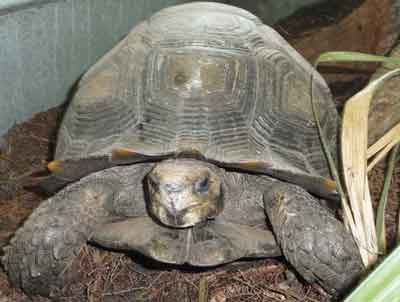Description:
Housing is sometimes problematic for these large, somewhat shy tortoises when it comes to space, temperatures and humidity requirements. Keeping them outdoors is best, but you must live in an area they can tolerate. Daytime temperatures should not exceed 85 degrees Fahrenheit, and night time lows should not drop below 55 degrees. A large pen, measuring at least 10 feet long by 10 feet wide will house a pair of adults. Walls should be at least 2½ feet tall. Humidity should be between 65 to 90 percent. If the area you live in does not have these humidity levels, misters, soaker hoses and other such devices must be used to raise the humidity. Shrubbery planted around the pen will give the tortoises a sense of security. These tortoises don’t burrow, so several large hides are required. A water feature large enough for all inhabitants to soak is needed, preferably in a shaded area of the pen. Smaller tortoises can also be housed outdoors, duplicating the needs of the adults. Younger Burms are very shy, and more hides might be required. You can also house them indoors, duplicating the climate and humidity levels. Once again, these tortoises get large, so a very large enclosure is required. If housing indoors, use heat lamps, heat emitters or other devices to achieve a thermal gradient of 90 degrees at the hotspot and 65 to 70 degrees at the cool end. Let the temperature drop naturally at night, but no lower than 50 degrees. Mostly herbivorous, but also eats animal protein. Greens can be used as a staple, along with beans, small amounts of fruit and melons and commercial woodland tortoise food. Food should be provided daily. If kept indoors, add a calcium supplement with D3, and if kept outdoors, add a supplement without D3. Offer these guys a bit of animal protein about two to three times per week in the form of high-grade canned or soaked dry dog food, whole pre-killed mice and monkey biscuits. At the recent International Herpetological Symposium, it was indicated that they also love corn. Add some corn to their diet. For years all Burmese mountain tortoises for sale in the United States were field-collected imports. They rarely thrived. However, with care and a lot of trial and error, captive breeding is becoming commonplace now. Captive-bred babies, subadults and adults are appearing more and more often. There are two subspecies: M. e. emys and M. e. phayrei. The latter is referred to as the black mountain tortoise and appears to be the rarer and more sought after of the two subspecies. For both, the general care is the same. I know of no color morphs for this species. You can find them for sale at specialty reptile stores, over the Internet and sometimes at reptile shows. The Burmese mountain tortoise is for more advanced tortoise keepers. The challenges of providing appropriate housing might make this a tough tortoise to keep. They do well outdoors in places like Florida, most of the southern states and San Diego, as well as the Pacific Northwest. Indoor housing helps eliminate outside variables, but then size is a factor. This is the fourth largest tortoise in the world. Ken Foose produced his first captive-bred snakes at age 11. With a Master’s Degree in zoology, he has been both a zookeeper and curator. He opened Exotic Pets, which specializes in reptiles and amphibians, in Las Vegas in 1991. He is currently president of the International Herpetological Symposium.
Habitat:
Humid areas of forest, evergreens and upland jungles
Range:
Assam, Myanmar, Thailand, the Malay Peninsula, Sumatra and Borneo
Scientific Name: Manouria emys emys and M. e. phayrei
Species Group: tortoise
Family: Testudinidae
Size: Close to 100 pounds for adults
Level: advanced
Weight: more-than-20-lbs
Dangerous: No


